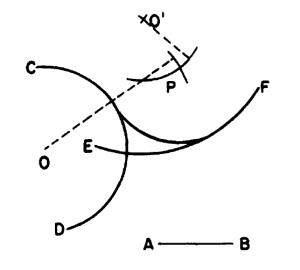
The problem in figure 4-36 is to draw an arc with a radius equal to AB, tangent to the circular arcs CD and EF. Set a compass to a spread equal to the radius of arc CD plus AB (indicated by the left-hand dashed line), and, with O as a center, strike an arc. Set the compass to a spread equal
to the radius of arc EF plus AB (indicated by the right-hand dashed line), and, with O´ as a center, strike an intersecting arc. The point of intersection between the two arcs (P) is the center of the circle of which an arc of given radius is tangent to arcs CD and EF. In figure 4-36 the circular arcs CD and EF curve in opposite directions.

In figure 4-37 the problem is to draw an arc with radius equal to AB, tangent to two circular arcs, CD and EF, that curve in the same direction. Set a compass to a radius equal to the radius of EF less AB, and, with O´ as a center, strike an arc. Then, set a compass to a radius equal to the radius of arc CD plus line AB, and, with O as center, strike an intersecting arc at P. The point of intersection of these two arcs is the center of the circle of which an arc of the given radius is tangent to CD and EF. When a circular arc is tangent to another, it is commonly the case that the two arcs curve in opposite directions. However, an arc may be drawn tangent to another with both curving in the same direction. In a case of this kind, the tangent arc is said to enclose the other.

An arc tangent to two others may enclose both, or it may enclose only one and not the other. In figure 4-38 the problem is to draw a circular arc with a radius equal to AB, tangent to and enclosing both arcs CD and EF. Set a compass to a radius equal to AB less the radius of CD (indicated by the dashed line from O), and, with O as a center, strike an arc. Set the compass to a radius equal to AB less the radius of EF (indicated by the dashed line from O´), and, with O´ as a center, strike an intersecting
arc at P. The point of intersection of these two arcs is the center of a circle of which an arc of given radius is tangent to, and encloses, both arcs CD and EF.

In figure 4-39 the problem is to draw a circular arc with a radius equal to AB, tangent to, and enclosing, CD, and tangent to, but NOT enclosing, EF. Set a compass to a radius equal to AB less the radius of arc CD (indicated by the dashed line from 0), and, with O as a center, strike an arc, Set the compass to AB plus the radius of EF (as indicated by the dashed line from O´), and, with O´ as a center, strike an intersecting arc at P. The point of intersection of the two arcs is the center of a circle of which an arc of the given radius is tangent to and encloses arc CD and also is tangent to, but does not enclose, arc EF.
(Source: NAVEDTRA 14069, U.S. Navy)

Very fantastic